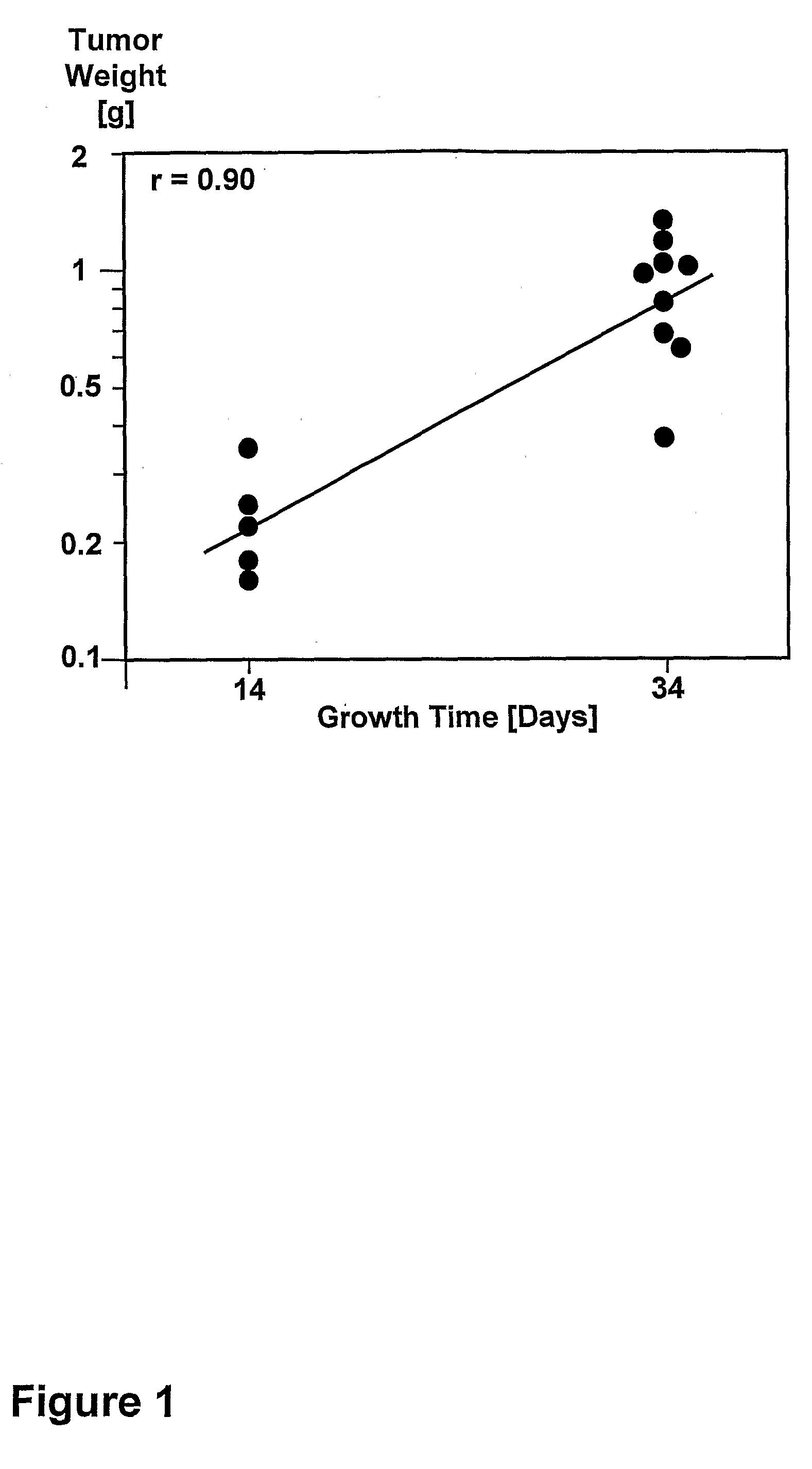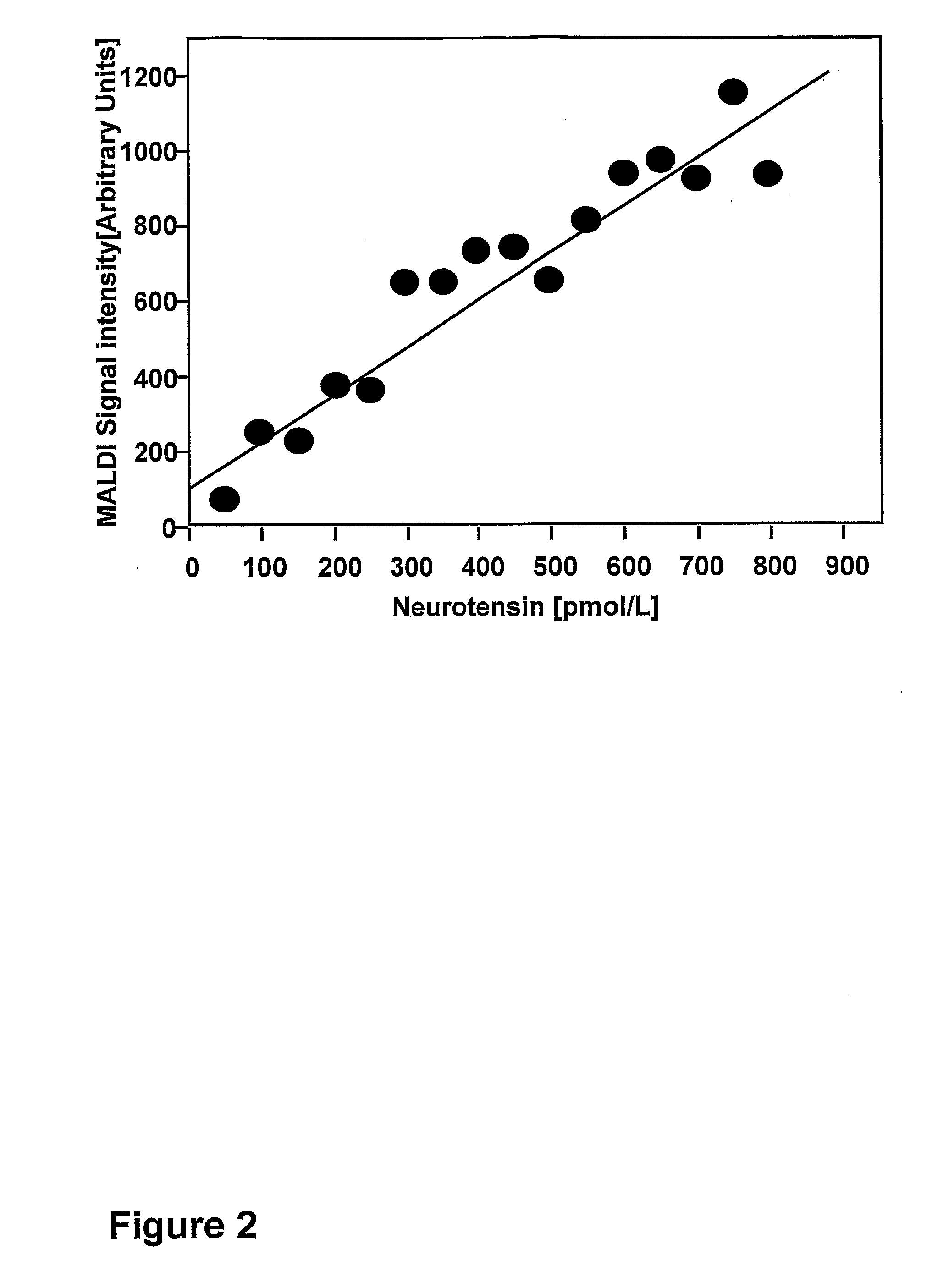[0043]Another
advantage of the invention is the use of immune-compromised experimental animals (hosts), which allows the xenograft to grow in the
organism of the
experimental animal without being subjected to the attacks of the
immune system of the host. This allows the analysis of almost any kind of cells such as for example neoplastic cells. In addition the immune-compromised experimental animals do not develop inflammatory reactions as a consequence of the xenograft. Consequently the peptides and / or proteins of the invention therefore are not the result of such an inflammatory reaction. This is a big
advantage, as inflammatory reactions take place in many different disorders, not just in for example neoplastic disorders and thus markers reflecting
inflammation are usually not very specific markers.
[0044]The peptides and / or proteins identified in the invention as potential markers of, for example, a neoplastic disorder, were subjected to various “environmental factors” within the
organism of the
experimental animal, which is a further
advantage of the peptides of the invention. This ensures that predominantly those peptides (markers, biomarkers) are identified, which survive the typical “environmental factors”, or which are generated as a consequence of these “environmental factors”. Markers which are very susceptible to
proteolytic degradation, or which stick very well to abundant
plasma proteins such as
albumin, or which are efficiently removed from the circulation being bound to proteins and / or receptors or which are excreted efficiently by the kidneys are not likely to be present in the
experimental animal in high concentrations. Therefore these markers are less likely to be identified in this invention and exactly these markers are also less suitable as marker for disorders such as neoplastic disorders. So the use of experimental animals selectively enriched those peptides and / or proteins which
in vivo survive well and therefore are more suitable as diagnostic markers. The
organism of the experimental animal simulates the fate of potential markers in the organism of a patient. Therefore the identified markers, such as TIF1-beta fragments represent markers which most likely are suitable for use in for example in
human cancer patients.
[0045]Another advantage of the invention is that many additional characteristics of for example disorders resulting from cells with a hyperproliferative disorder and / or resulting from cells with a differentiation disorder and / or resulting from neoplastic cells, i.e. cells malfunctioning in proliferation and differentiation, can be analyzed and as a consequence markers with special, advantageous characteristics can be identified. For example it is possible to identify markers, which correlate with certain properties or characteristics of a tumor (neoplastic cells) such as the size of the tumor, the physical location of the tumor, the tendency of the tumor to form metastases, the type of the tumor for example a colon tumor which is positive for certain receptors, etc. All of these types of markers generally cannot be identified using other methods which use
in vitro grown
tumor cells for marker identification. On the other hand getting tumor samples from human patients with defined certain properties or characteristics is difficult, as it is ethical not justifiable to manipulate or treat human patients like experimental animals. In addition human patients are much more diverse regarding their
phenotype, than genetically nearly identical inbred experimental animals housed under standardized conditions. Therefore experimental studies directly working with
human patient samples comprise much more uncertain and unknown variables which may hide markers, which are detectable, if the method described in this invention is used.
[0046]A further advantage of the markers of the invention is the possibility that the identified markers of cells with a hyperproliferative disorder and / or cells with a differentiation disorder and / or neoplastic cells, may also be suitable to predict the success of a treatment to remove, kill or suppress the growth or viability of said cells within a living organism such as a patient. With viability is meant that cells are still alive, but do not proliferate at all or do proliferate at a lower than usual rate. Therefore it is possible to identify with the methods described in this invention markers for monitoring the therapeutic success or even for predicting a therapeutic success even before the treatment has started. This can be done in general with certain types of cells with a hyperproliferative disorder and / or certain types of cells with a differentiation disorder and / or certain types of neoplastic cells, but it also can be done with purified cells or tissues of a certain, individual patient, thereby identifying a tailor-made, patient-specific marker for a disorder or for predicting the therapy success or for monitoring the potential relapse of the treated disorder in an individual patient.Experimental Animals / Immune-Compromised Host
[0047]Preferably the experimental animals used are non-human hosts, non-human mammals, preferably rodents, preferably mice or rats, preferably animals with impaired
immune system e.g. immune-compromised animals, regardless of the reason for the impairment of the
immune system. With immune-compromised animals is meant any kind of animal with an immune
system which is suppressed to such an extend, that xenografts from a species different to said animal, preferably xenografts originating from human cells, human tissues, human organs, human tumors, etc., survive for longer periods of time within the organism of said animal without being destroyed by the immune
system of said immune-compromised animal. With longer periods of time is meant at least 1 day, preferably 2, 3, 4, 5, 6, 7, 14, 21, 28 days, 1, 2, 3, 4, 5 or 6 months or even longer periods of time. Depending on the growth-rate and on the number of cells or the amount of tissue or the size of the tumor or organ representing the xenograft, different periods of times are possible. Fast growing xenografts can be grown only for shorter periods of time
ranging from days to several weeks, whereas slowly growing or not growing xenografts can be present within the organism of the animal for longer periods of time in the range of several months. The animal can be of any species, but species commonly used in laboratories such as mice, rats, guinea pigs, rabbits, goats, pigs, monkeys, dogs, cats, etc. are preferred.
[0048]The reason for the impaired immune
system among others can be a natural genetic defect of the animal, a disorder of the animal or an experimental treatment of the animal. Experimental treatments among others can be surgical modifications of the animal, physical treatment of the animal, genetic manipulation of the animal or the treatment of the animal with substances inhibiting or destroying the immune system of the animal. An example of a surgical modification resulting in an immune-compromised experimental animal is the
surgical removal of the thymus. An example of a physical treatment of animals, resulting in an compromised immune system is the destruction of the
bone marrow by
irradiation or by sub lethal
irradiation of the
whole animal. Genetic defects of the experimental animal can be caused by mutations present in nature or by experimentally induced random or specific mutations of the animal resulting in for example a genetic
knockout animal or a transgenic animal. Examples of genetic defects, resulting in a compromised immune system are
SCID mice (severe combined
immunodeficiency), Prkdc (
protein kinase DNA activated catalytic polypeptide
gene defect), nude mice and rats (Foxn1 (forkhead box N1) defect), Rag1 mice (Rag1=recombination activating
gene 1), beige mice (bg<J>
mutation and animals of other species with a deletion of at least one of the genes selected from the group comprising of Foxn1, Prkdc, Rag1, bg<J>
gene, MHC II (
major histocompatibility cluster II) and ADA (
adenosine desaminase). These experimental animals with genetic defects are for example available from the Jackson Laboratories, Bar Harbor, Me., USA or from Taconic Farms, Germantown N.Y., USA. It is possible to combine two or more immune-compromised animal models, for example by cross-breeding of different genetically immune-compromised mice strains, or by
irradiation of a normal rat resulting in complete destruction of its
bone marrow and subsequent
transplantation of for example
bone marrow of
SCID mice to the irradiated rat resulting in some kind of a SCID-like rat (
Transplantation, 1997, 64:1541-50). Furthermore certain viruses result in immune-compromised animals such as for example the
simian immunodeficiency virus or the simian /
human immunodeficiency virus and consequently experimental animals infected with such viruses can be used according to the invention. Substances inhibiting the immune system (immunosuppressants) can be used to enable the survival and / or growth of xenografts according to the invention. Examples of such drugs are among others cyclosporine,
cortisone,
prednisolone, azathioprine,
cyclophosphamide,
tacrolimus,
prednisone,
mycophenolate and
sirolimus. Also certain antibodies such as anti-CD3 antibodies, which inhibit T-
cell function (muromonab-CD3) can be used as immunosuppressants to enable survival and / or growth of xenografts in experimental animals.Alternatives to Immune-Compromised Animals
 Login to View More
Login to View More 


